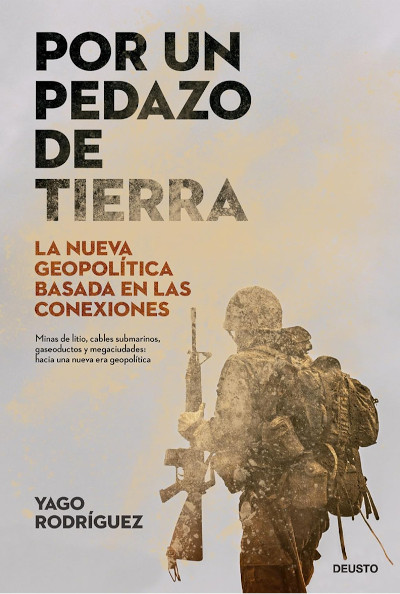In the picture
Cover of the book by Yago Rodríguez 'Por un pedazo de tierra. La nueva geopolítica basada en las conexiones' (Barcelona: Deusto, 2024) 414 pp.
Sometimes, the great finding is to join the dots: then an image appears that explains everything and that before, due to the dispersion of its elements, could not be seen. It is not that Yago Rodríguez, director of the medium 'Political Room', handles new components -there are the usual factors of geopolitics understood in its most geographical sense-, but he joins them in such a way that he offers a new "intelligence", a new way of understanding the procedures that explain the ultimate dynamics of the world.
On the one hand, there is the concept of the "connecting cycle" defined as "the set of exchanges, of connections established by human beings over a period of time". Connections (transport, communications) are accelerated by technologies, whose cycle of impact on human civilization shapes these connector cycles. "The actors who succeed in effecting this cycle the fastest are those who will become the most powerful and, therefore, the powers will strive to accelerate their own cycles and obstruct those of their adversaries." The hastening and shortening of cycle time - the sailing that facilitated overseas trade had a centuries-long shelf life; the digital age has brought realities that expire every few years, while Artificial Intelligence pushes us into a future we view with giddiness - has meant that an actor like China can compete with the hegemon we knew, the United States, by jumping early into the AI cycle.
On the other hand, the author introduces the idea of the "golden belt", the imaginary line that connects by sea the most important points or zones of the planet (important for their strategic value due to the generation and concentration of wealth, for being places of friction of the main hubs or bottlenecks in global maritime communication). This line, which cuts the world in half like an irregularly split watermelon, links Japan, Korea, China, the South China Sea, Malacca, India, Hormuz, the Red Sea, the Mediterranean, the English Channel, the East Coast of the United States, the Panama Canal, Mexico and the West Coast of the United States, completing its diameter through the Pacific. In order to determine this route, not entirely new concepts are used, such as the 'frictors' or the voids (such as the Amazon or the Saharan), to which the author gives some specific details. Thus, for example, he speaks of the Tibetan void, which leads him to mark on the map a average Asian moon between China, part of Indochina and India, or the Congolese void, which would come to separate two nuclei of African countries (the "Atlantic balcony", around the Gulf of Guinea, and the "African axe", around the horn of that continent in the Indian Ocean).
To make all this intelligible without the convenient cartography would have been an impossible task, so the book includes several maps that allow a good understanding of the thesis and the subtheses that Yago Rodriguez raises.
It is a courageous work, which does not simply reiterate the usual assertions of geopolitics, but wishes to provide a new theoretical interpretation of geopolitics. This is probably an excessive ambition, since the value of connections has generally already been present in the development of the discipline; the aspect of cycle and acceleration has also been considered previously in relation to technology or areas such as demography (the demographic boom, which partly explains the consecutive rise of the major powers, has been shorter and shorter, reaching the extreme of China, which became an old woman before reaching opulence).
In any case, Yago Rodriguez's work is highly suggestive, easy to read and follow -complying here with the purpose of being informative without losing rigor-, with innovative ideas, such as giving prominence as "connectors" to the most geopolitically valuable large cities or the reflection on "avatarization", which represents an interesting prospective element: B digital universes, in which we humans will spend a large part of our lives, will mean an increase in the consumption of electrical energy and will require further deepening of the "energization" of our world.

